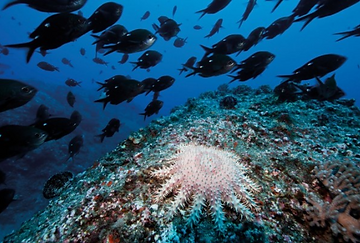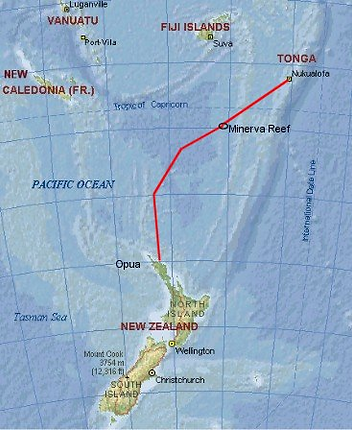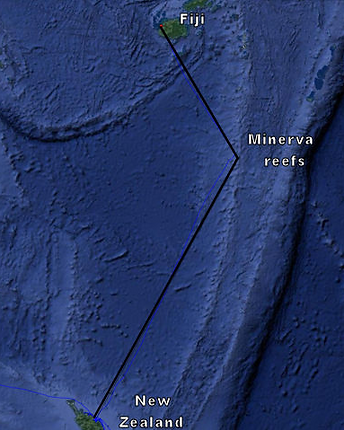Minerva Reefs: Fiji and Tonga dispute
Overview and Geopolitical context of the conflict:
When we picture the islands that make up Oceania, we tend to think of them as delightful and quiet places where nothing violent happens. Nonetheless, these islands are not always the paradise many people wish it to be. During the last decades, instability and some conflicts in Oceania has arisen. One example of these conflicts could be the one taking place over Minerva Reefs, a group of two mostly submerged atolls located in the Pacific Ocean that are under dispute between Fiji and Tonga.

Minerva Reefs (North and South Minerva) Source: Dave Saggs
Minerva Reefs lie some 315 miles southwest of Tonga, 430 miles southeast of Fiji, and 970 miles northeast of New Zealand, and are two submerged atolls that are on a submarine platform from 549 to 1,097 metres below the surface of the sea. We can differentiate between North Minerva, which is circular with a diameter about 5’6 kilometres, and South Minerva, another circular atoll with a diameter about 4’8 kilometres that is parted into the East Reef and the West Reef.
Moreover, these reefs are used as anchorages by yachts traveling between New Zealand and Tonga or Fiji and contain lots of coral formations that are turning this place into a biodiversity rich zone. Anemones, algae and soft corals live in the reef-building structures attracting a huge range of marine fauna that goes from large reef fish to sharks. Therefore, there are human activities derived from it as diving, snorkelling or fishing, which are in turn contributing to tourism, giving this way another advantage that can be attractive for the two nations disputing the owning of the place.


Source: New Zealand Geographic
The main problems that Minerva Reefs is facing are due to their complex position in Oceania. With the extension of jurisdiction over resources and certain activities to 200 nautical miles or more, many seabed areas are subject to be claimed by multiple nations, and that is the case of Minerva Reefs. Since the zone is situated in an overlapping area (they are situated between, there are two nations, Fiji and Tonga interested in it, so there is an unresolved boundary situation concerning this zone.
The fact is that Tonga claimed Minerva Reefs as islands in 1972 after the shadowy US Phoenix Foundation shipped in dirt and declared it a republic, so Minerva Reefs were annexed to Tonga. Even though, Fiji has not recognized the annexation, as Fiji Economic Zone also enclose the Reefs. Thus, the borders became economically significative, and Fiji confirmed in 2005 that it did not recognize the maritime claims that Tonga made under the United Nations Conventions on the Law Of Sea agreements with filling a complaint in 2005 with the International Seabed Authority.
Moreover, it is also important to bear in mind that the Tongan Government has built an artificial island and installed navigation beacons on both Minerva’s in order to transform the Reefs themselves only as low-tide elevations. Thus, they would not have territorial sea. Even so, Minerva Reefs are under Fiji’s Exclusive Economic Zone, so the right of Tonga to construct or use artificial islands is complicate. Hence, it can be seen that there is a complicate conflict involving the property of Minerva Reefs, that it has been increased during the last years according to the increase of economic interests implicated on it.


Map of the area of the conflict Source: Sailing logic
Global implications and position of international organizations
Although Tonga and Fiji have historically kept good bilateral relations and a peaceful alliance, these may now be affected by the territorial dispute over Minerva Reefs. In February 2011, Fiji and Tonga denied any trace of conflict. The Fiji government said there was "no official dispute" between the two countries, but that UN officials from the two sides were leading discussions on the matter (Radio New Zealand 2011). After Fiji’s destruction of Tonga’s navigation equipment in May 2011, Fiji’s Deputy Permanent Secretary of Foreign Affairs Sila Balawa declared that Tonga remained "one of Fiji’s closest friends" and hoped that the disagreement would be resolved through "peaceful dialogue". On the other hand, the Tongan government described Fiji’s destruction as “an act of vandalism”, threatening the international shipping, but stressed the need to resolve the dispute “under International law for the settlement of disputes between civilized societies". In early June 2011, Tonga sent new ships to the Reef in order to replace the destroyed equipment, but this time Fijian ships reportedly withdrew from the zone, avoiding further tension and the emergence of a military conflict. In a report from the Ministry of Foreign Affairs, the Government of Fiji reiterated its claims over the Minerva Reefs and stated that any challenge to Fijian territorial maritime boundary had to be “directed to the United Nations dispute resolution mechanism in the International Tribunal on the Law of the Sea” (Ministry of Foreig Affairs 2011). Finally, as an attempt to end the conflict, Tonga’s land minister Lord Ma'afu suggested, in 2014, the exchange of islands with Fiji. He proposed ceding the Minerva Reefs in return for Fiji’s Lau islands groups, which represent more than half of Fiji’s total sea. Fiji’s government awaits the formal proposal but the provincial council of Lau remains skeptical about the offer (BBC News 2014).
As of today, the territorial dispute remains unresolved. Since both sides deny any official conflict, discussions have not reached any supranational entities, and no international governmental organisations have clarified their position on the matter. This does not mean, however, that the dispute does not have global implications. On the contrary, other States may become involved, motivated mainly by economical interests. According to IHS Global Insight, a London based strategic analyst firm, “scientific expeditions have shown that the water between Fiji, Tonga and New Zealand are among the most potentially lucrative in the world for relatively easily accessible minerals” (Field 2011). Statements from the Canadian company Nautilus Minerals and its partner Teck Cominco Ltd, which explored areas to the north of Minerva, claimed that the seabed in that area is rich in gold, copper, zinc and silver. This may awaken the interests of other countries. It is the case of New Zealand, whose continental shelf claims could intersect with Minerva Reefs. Diplomatic sources have noted that New Zealand has never formally recognised Tonga’s claim and that could oddly find itself backing Fiji’s claim over the territory. In addition, South Korea, China and Australia are also reportedly seeking prospecting rights in the region.
Bibliography
Articles/books:
Samuel Pyeatt Menefee, "Republics of the Reefs: Nation-Building on the Continental Shelf and in the World's Oceans," California Western International Law Journal 25, no. 1 (Fall 1994): 81-112
Mark J. Valencia, "Taming Troubled Waters: Joint Development of Oil and Mineral Resources in Overlapping Claim Areas," San Diego Law Review 23, no. 3 (May-June 1986): 661-684
Murray, W. E., & Storey, D. (December 2003). Political conflict in postcolonial Oceania. Palmerston North, New Zealand: Blackwell Publishing. http://www2.kobe u.ac.jp/~alexroni/TR2014%20readings/2014_5/Political%20conflict%20in%20postcolonial%20Oceania.pdf
Jürgen Buchholz, Hanns. Law of the Sea Zones in the Pacific Ocean. Singapur: Institute of South East Asian Studies.
Government of Fiji. Ministry of Foreign Affairs. "The Government of Fiji Today Reiterates That Minerva Reef Is within Fiji's Territorial Waters and Any Challenge to This Widely Accepted Fijian Territorial Maritime Boundary Must Be Directed to the United Nations Dispute Resolution Mechanism in the International Tribunal on the Law of the Sea [ITLOS]." News release, June 14, 2011. Accessed May 23, 2018. http://www.foreignaffairs.gov.fj/media-resources/media-release/335-minerva-reef-is-within-fijis-eez.
United States of America. United States Department of State. The Geographer Bureau of Intelligence and Research. Limits in the Seas. Vol. Fiji's Maritime Claims. Series 101. 1984.
Websites:
Xinhua. "Tonga, Fiji Dispute Again over Minerva Reef Claims of Ownership: Reports." Top 10 Attractions in Shaanxi, China (3) - People's Daily Online. Accessed May 23, 2018. http://en.people.cn/90001/90777/90851/7407519.html.
Writer, Guest. "Fiji vs Tonga to Rights of Minerva Reef." AquaNerd. May 23, 2011. Accessed May 22, 2018. http://aquanerd.com/2011/05/fiji-vs-tonga-to-rights-of-minerva-reef.html.
"Fiji–Tonga Relations." Literary Merit. Accessed May 23, 2018. https://ipfs.io/ipfs/QmXoypizjW3WknFiJnKLwHCnL72vedxjQkDDP1mXWo6uco/wiki/Fiji–Tonga_relations.html.
Pike, John. "Minerva Reefs." Vietnam War - American Return to Dog Fighting. Accessed May 23, 2018. https://www.globalsecurity.org/military/world/oceania/minerva.htm.
"Minerva Reefs." Wikipedia. Accessed May 23, 2018. https://en.wikipedia.org/wiki/Minerva_Reefs.
Radio New Zealand. "Fiji and Tonga take wrestle over Minerva Reef to the United Nations". Accessed May 23, 2018. http://www.radionz.co.nz/international/pacific-news/195315/fiji-and-tonga-take-wrestle-over-minerva-reef-to-the-united-nations
Newspaper articles:
Frankham, James. «Empire of the sea.» New Zealand Geographic, s.f.https://www.nzgeo.com/stories/empire-of-the-sea/
Fiji disputes with Tonga over Minerva Reef. (27 de May de 2011). Global Times. http://www.globaltimes.cn/content/659746.shtml
Trumbull, R. (27 de February de 1972). PACIFIC ISLANDERS FIGHT REEF PLAN. New York Times.
Tonga wants to swap islands with Fiji. (4 de July de 2004). BBC. http://www.bbc.com/news/blogs-news-from-elsewhere-28160699
Field, M. (10 de February de 2011). Minerals behind Tonga, Fiji border spat? Stuff. http://www.stuff.co.nz/business/world/4640775/Minerals-behind-Tonga-Fiji-border-spat